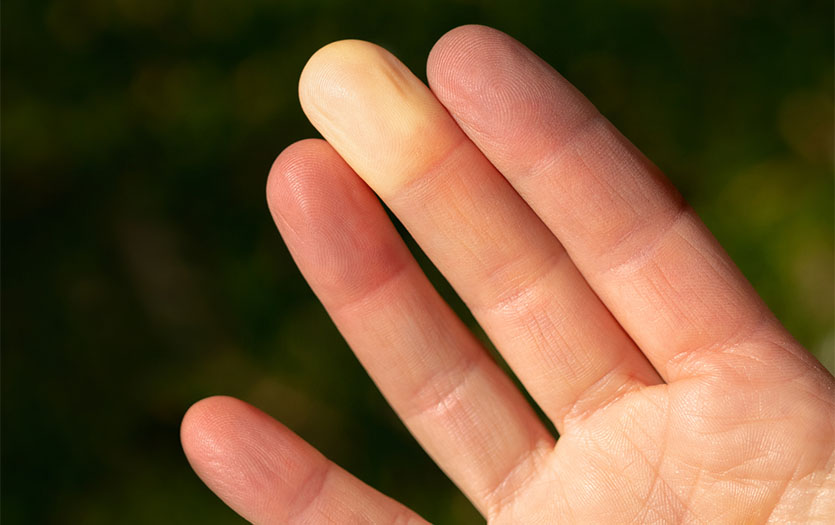
This post was written by Aya Balan, DO, PPG - Internal Medicine, Parkview Residency Center.
We all know how unpleasant cold hands can feel on a chilly day, but for some people, this sensation is very extreme. Raynaud’s syndrome is a condition that causes certain parts of your body to feel numb, cold, and even painful. This happens when blood vessels constrict in response to cold temperatures or stress. In this post, we'll break down the causes, symptoms and treatments for Raynaud’s to help you better understand and manage this condition.
What is it?
Raynaud’s syndrome occurs when blood flow to some areas of the body becomes constricted, usually in the fingers and toes. When these small blood vessels tighten or spasm, it can sometimes even affect the ears and nose. This can cause the skin to turn white or blue due to the lack of blood flow, and then red when the blood flow returns.
Who is affected and why?
Raynaud’s phenomenon is relatively common, especially in colder climates. Up to 20% of the adult population worldwide is affected. Women are more likely to be affected than men. Individuals affected by Raynaud’s first notice it between the ages of 15 and 30. Although anyone can develop Raynaud’s, there are some risk factors for this condition. These include:
-
Family history of Raynaud’s
-
Living in a cold environment
-
Working with vibrating tools
-
Pre-existing autoimmune conditions.
There are two main types of Raynaud’s disease. The first type is primary Raynaud’s, which is the most common and typically occurs alone without any other associated health problems. It is also generally less severe and tends to have fewer complications. The exact cause of primary Raynaud’s syndrome is not completely understood, but it may be due to an overactivation of the body’s natural response to cold or stress.
Secondary Raynaud’s is often caused by an underlying medical condition, especially those that affect the blood vessels or connective tissues. These include lupus, scleroderma and rheumatoid arthritis. Secondary Raynaud’s is more serious and may involve more severe complications, including ulcers on the skin and, in rare cases, tissue damage.
Certain medications, such as those for migraines, blood pressure and chemotherapy, can also trigger Raynaud’s phenomenon.
Stages of Raynaud’s phenomenon
There are usually three stages associated with Raynaud’s syndrome. The first is the constriction (vasospasm) stage. During this stage, the body is exposed to cold or stress, which causes the small blood vessels to constrict. This may cause the fingers or toes to turn white due to decreased blood flow and is usually associated with a sensation of numbness or tingling.
The second stage is the blue (cyanosis) stage. With this stage, a lack of oxygen causes the skin to turn a bluish color. This can be painful and cause the affected area to feel even colder.
The last stage is the red (recovery) stage, which occurs when the blood vessels relax and normal circulation returns. The area often turns red and may even throb or feel warm. Sometimes, there can be a burning sensation or swelling during this stage. These attacks can last from several minutes to a few hours, depending on the type of Raynaud’s and the associated triggers.
Treatment options
There is no cure for Raynaud’s, but there are ways to manage this condition and decrease the frequency and severity of attacks. The key is to prevent triggers that cause blood vessels to constrict.
-
Keep warm. Wearing insulated gloves and socks can go a long way in preventing attacks.
-
Manage stress. Practicing relaxation techniques can be very beneficial for people whose attacks are triggered by heightened emotions.
-
Avoid smoking. Nicotine constricts blood vessels and can make Raynaud’s worse.
For more severe cases, your doctor may prescribe a medication that improves blood flow. The most commonly prescribed drugs are calcium channel blockers, such as nifedipine or amlodipine. For people with secondary Raynaud’s, it is essential to treat the underlying condition to help control the symptoms.
Final thoughts
It may be difficult and uncomfortable to live with Raynaud’s syndrome, but with the right management strategies, most people can live long, healthy lives. Understanding what triggers your symptoms and taking steps to avoid those triggers can help. If you are experiencing frequent or severe attacks, it may be beneficial to talk to your doctor about other treatment options to prevent complications.
The PPG – Internal Medicine, Parkview Residency Center allows you to have a resident physician as part of your care team. Your care plan at the residency center will be overseen by two qualified physicians who will work together to help you achieve your health goals. Visit our Parkview Residency Center FAQ page for more information or call 260-373-7765 to make an appointment with one of our internal medicine residents.



